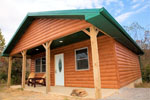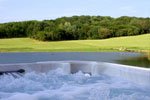HORSESHOE LAKE STATE FISH WILDLIFE AREA
As you explore the Horseshoe Lake State Fish & Wildlife Area, you may be reminded of the Deep South. The charm of bald cypress, tupelo gum, swamp cottonwood trees and wild lotus makes the recreational activities at the site even more enjoyable.
Located in Alexander County just east of Illinois Route 3 seven miles north of Cairo, the 10,200 acre area includes a 2,400 acre shallow lake. In addition to taking in the beauty of the natural features of the area, visitors enjoy picnicking, camping, boating, fishing and hunting.
The first 49 acres of the park were purchased by the Department of Conservation in 1927 for development as a Canada Goose sanctuary. Additional tracts of land, including Horseshoe Island, continued to be purchased to create the State Fish & Wildlife Area that greets visitors today.
Canada geese began wintering at the site in 1928. The original 1,000 birds increased to a population of more than 40,000 by 1944. Today, up to 150,000 Canada geese winter at the site, thanks to improved refuge management and harvest controls.
Horseshoe Lake
With its large stands of beautiful trees around its 20 mile shoreline, Horseshoe Lake is a beautiful body of water. Since 1930, when a concrete, fixed spillway was constructed, the lake has maintained a constant four-foot depth.Refuge Area
Horseshoe Island, Horseshoe Lake and all areas not designated for public hunting are used to maintain and support the Canada goose population. A variety of food requirements are met by producing green pasture and grain crops in the refuge. Research programs, including banding, provide important information about the geese. Over 50,000 birds have been trapped, banded and releasedthrough the years at Horseshoe Lake.Natural Features
Bald cypress, tupelo gum and swamp cottonwood trees surround Horseshoe Lake and create spectacular scenery. Flora and fauna normally found in swampland much further south thrive in this setting. Visitors during fall and winter see large populations of waterfowl and bald eagles. Spring and summer guests will enjoy the vibrant colors of the foliage. Some of the most beautiful blooms are found on red buckeye shrubs in April and wild lotus in June.
Native southern hardwood forests are abundant, and two large, undisturbed tracts have been dedicated as Illinois Nature Preserves. These preserves are open to visitors, but are also used for scientific research and education.
Day-UseFishingyes
Huntingyes
Hiking Trailyes
Swimming Beachyes
Bike Trailsyes
BoatingLaunch Rampsyes
CampingPrimitiveyes
WinterActivitiesyes
With all the beautiful view and recreational activities at Horseshoe Lake to choose from, you may wish to stay a few days to experience them all. There are 38 Class A camping sites with electricity and showers, 40 Class B/E camping sites with electricity only, and 10 Class C sites available for overnight guests.




